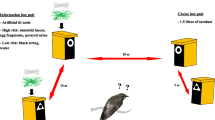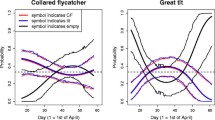Abstract
There is increasing evidence for species using information from heterospecifics to assess predation risk or habitat quality. Notably, a series of influential studies, using geometric symbols added to nest boxes, has shown that migratory flycatchers copy tits’ apparent nest-site preferences and settle in nest boxes bearing the same symbol as tits’ nest boxes. This “Selective Interspecific Information Use” hypothesis was recently challenged by the “Owner Aggression” hypothesis, stating that nest occupancy patterns are instead driven by tits aggressively excluding flycatchers from particular empty boxes to use as potential re-nesting sites after nest predation. Here, I propose the “Adaptive Interspecific Information Use” hypothesis, which outlines the predicted fitness benefits of nest-site copying or rejecting, and, importantly, provides an explanation for inconsistent experimental results to date. Indeed, neither previous hypotheses satisfactorily explains why flycatchers switch from copying to avoiding tits’ preferences, when tits’ clutch sizes are small or tits are at the laying stage. Adding to the recent debate, I show how predictable changes in nest predators’ search image and tits’ anti-predator behaviour may explain this variation. Indeed, incubating tit species aggressively defend their nest against nest predators, including by emitting snake-like vocalisations, which may generally deter predators from boxes bearing a tit nest symbol. By contrast, the undefended tit nests—which occur during laying before incubation starts, or potentially in individuals with small clutches—are easy prey that predators may specifically target. If predators cue on tit nests’ symbol, I therefore predict that, to reduce predation risk throughout the season, flycatchers may switch from avoiding the symbol of undefended tit nests to preferring the symbol of tits incubating large clutches. I propose experiments to test these predictions. Overall, considering nest-site copying in the landscape of fear framework, rather than invalidating the Selective Interspecific Information Use hypothesis, may be key to understand its evolution.
Similar content being viewed by others
References
Bebbington K, Hatchwell BJ (2016) Coordinated parental provisioning is related to feeding rate and reproductive success in a songbird. Behav Ecol 27:652–659. https://doi.org/10.1093/beheco/arv198
Bond AB, Kamil AC (2002) Visual predators select for crypticity and polymorphism in virtual prey. Nature 415:609–613. https://doi.org/10.1038/415609a
Boucaud ICA, Valere PA, Smith M, Doligez B, Cauchard L, Rybak F, Vignal C (2016) Interactive vocal communication at the nest by parent great tits Parus major. Ibis 158:630–644. https://doi.org/10.1111/ibi.12374
Boulinier T, Danchin E (1997) The use of conspecific reproductive success for breeding patch selection in terrestrial migratory species. Evol Ecol 11:505–517
Boulinier T, Mariette MM, Doligez B, Danchin E (2008) Choosing where to breed: breeding hatbitat choice. In: Danchin E, Giraldeau LA, Cezilly F (eds) Behavioural Ecology. Oxford University Press, Oxford
Doligez B, Clobert J (2003) Clutch size reduction as a response to increased nest predation rate in the collared flycatcher. Ecology 84:2582–2588. https://doi.org/10.1890/02-3116
Doligez B, Danchin E, Clobert J (2002) Public information and breeding habitat selection in a wild bird population. Science 297:1168–1170
Dugatkin LA (1992) Sexual selection and imitation-females copy the mate choice of others. Am Nat 139:1384–1389. https://doi.org/10.1086/285392
Dukas R, Kamil AC (2001) Limited attention: the constraint underlying search image. Behav Ecol 12:192–199. https://doi.org/10.1093/beheco/12.2.192
Forsman JT, Monkkonen M, Helle P, Inkeroinen J (1998) Heterospecific attraction and food resources in migrants’ breeding patch selection in northern boreal forest. Oecologia 115:278–286. https://doi.org/10.1007/s004420050517
Forsman JT, Seppanen J-T (2011) Learning what (not) to do: testing rejection and copying of simulated heterospecific behavioural traits. Anim Behav 81:879–883. https://doi.org/10.1016/j.anbehav.2011.01.029
Forsman JT, Seppanen JT, Monkkonen M (2002) Positive fitness consequences of interspecific interaction with a potential competitor. Proc R Soc B 269:1619–1623. https://doi.org/10.1098/rspb.2002.2065
Forsman JT, Seppanen J-T, Monkkonen M, Thomson RL, Kivela SM, Krams I, Loukola OJ (2018) Is it interspecific information use or aggression between putative competitors that steers the selection of nest-site characteristics? A reply to Slagsvold and Wiebe. J Avian Biol 49:jav–01558. https://doi.org/10.1111/jav.01558
Forsman JT, Thomson RL, Seppanen JT (2007) Mechanisms and fitness effects of interspecific information use between migrant and resident birds. Behav Ecol 18:888–894. https://doi.org/10.1093/beheco/arm048
Gaynor KM, Brown JS, Middleton AD, Power ME, Brashares JS (2019) Landscapes of fear: spatial patterns of risk perception and response. Trends Ecol Evol 34:355–368. https://doi.org/10.1016/j.tree.2019.01.004
Goodale E, Beauchamp G, Magrath RD, Nieh JC, Ruxton GD (2010) Interspecific information transfer influences animal community structure. Trends Ecol Evol 25:354–361. https://doi.org/10.1016/j.tree.2010.01.002
Ibanez-Alamo JD, Magrath RD, Oteyza JC, Chalfoun AD, Haff TM, Schmidt KA, Thomson RL, Martin TE (2015) Nest predation research: recent findings and future perspectives. J Ornithol 156:S247–S262. https://doi.org/10.1007/s10336-015-1207-4
Ishii Y, Shimada M (2012) Learning predator promotes coexistence of prey species in host-parasitoid systems. Proc Natl Acad Sci U S A 109:5116–5120. https://doi.org/10.1073/pnas.1115133109
Jennions MD, Petrie M (1997) Variation in mate choice and mating preferences: a review of causes and consequences. Biol Rev 72:283–327. https://doi.org/10.1017/s0006323196005014
Kivela SM, Seppanen JT, Ovaskainen O, Doligez B, Gustafsson L, Monkkonen M, Forsman JT (2014) The past and the present in decision-making: the use of conspecific and heterospecific cues in nest site selection. Ecology 95:3428–3439. https://doi.org/10.1890/13-2103.1
Koosa K, Tilgar V (2016) Is hissing behaviour of incubating great tits related to reproductive investment in the wild? Acta Ethol 19:173–180. https://doi.org/10.1007/s10211-016-0239-y
Krams I, Vrublevska J, Koosa K, Krama T, Mierauskas P, Rantala MJ, Tilgar V (2014) Hissing calls improve survival in incubating female great tits (Parus major). Acta Ethol 17:83–88. https://doi.org/10.1007/s10211-013-0163-3
Laundre JW, Hernandez L, Altendorf KB (2001) Wolves, elk, and bison: reestablishing the “landscape of fear” in Yellowstone National Park, USA. Can J Zool 79:1401–1409. https://doi.org/10.1139/cjz-79-8-1401
Lewis AC (1986) Memory constraints and flower choice in Pieris rapae. Science 232:863–865. https://doi.org/10.1126/science.232.4752.863
Lima SL (2009) Predators and the breeding bird: behavioral and reproductive flexibility under the risk of predation. Biol Rev 84:485–513. https://doi.org/10.1111/j.1469-185X.2009.00085.x
Loukola OJ, Seppanen JT, Krams I, Torvinen SS, Forsman JT (2013) Observed fitness may affect niche overlap in competing species via selective social information use. Am Nat 182:474–483. https://doi.org/10.1086/671815
Magrath RD, Haff TM, Fallow PM, Radford AN (2015) Eavesdropping on heterospecific alarm calls: from mechanisms to consequences. Biol Rev 90:560–586. https://doi.org/10.1111/brv.12122
Mariette MM, Griffith SC (2012a) Conspecific attraction and nest site selection in a nomadic species, the zebra finch. Oikos 121:823–834. https://doi.org/10.1111/j.1600-0706.2011.20014.x
Mariette MM, Griffith SC (2012b) Nest visit synchrony is high and correlates with reproductive success in the wild zebra finch Taeniopygia guttata. J Avian Biol 43:131–140. https://doi.org/10.1111/j.1600-048X.2012.05555.x
Martin TE (1988) On the advantage of being different-nest predation and the coexistence of bird species. Proc Natl Acad Sci U S A 85:2196–2199. https://doi.org/10.1073/pnas.85.7.2196
Martin TE (1996) Fitness costs of resource overlap among coexisting bird species. Nature 380:338–340. https://doi.org/10.1038/380338a0
Martin TE, Li PJ (1992) Life-history traits of open vs cavity-nesting birds. Ecology 73:579–592. https://doi.org/10.2307/1940764
Martin PR, Martin TE (2001) Ecological and fitness consequences of species coexistence: a removal experiment with wood warblers. Ecology 82:189–206. https://doi.org/10.2307/2680096
Merila J, Wiggins DA (1995) Interspecific competition for nest holes causes adult mortality in the collared flycatcher. Condor 97:445–450. https://doi.org/10.2307/1369030
Mery F, Varela SAM, Danchin E, Blanchet S, Parejo D, Coolen I, Wagner RH (2009) Public versus personal information for mate copying in an invertebrate. Curr Biol 19:730–734. https://doi.org/10.1016/j.cub.2009.02.064
Montgomerie RD, Weatherhead PJ (1988) Risks and rewards of nest defense by parent birds. Q Rev Biol 63:167–187. https://doi.org/10.1086/415838
Morinay J, Forsman JT, Kivela SM, Gustafsson L, Doligez B (2018) Heterospecific nest site copying behavior in a wild bird: assessing the influence of genetics and past experience on a joint breeding phenotype. Front Ecol Evol 5. https://doi.org/10.3389/fevo.2017.00167
Mouton JC, Martin TE (2018) Fitness consequences of interspecific nesting associations among cavity-nesting birds. Am Nat 192:389–396. https://doi.org/10.1086/698873
Olendorf R, Rodd FH, Punzalan D, Houde AE, Hurt C, Reznick DN, Hughes KA (2006) Frequency-dependent survival in natural guppy populations. Nature 441:633–636. https://doi.org/10.1038/nature04646
Parejo (2016) Informational mismatches: a neglected threat of climate change to interspecific interactions. Front Ecol Evol 4:31. https://doi.org/10.3389/fevo.2016.00031
Parejo, Aviles JM, Rodriguez J (2012) Alarm calls modulate the spatial structure of a breeding owl community. Proc R Soc B 279:2135–2141. https://doi.org/10.1098/rspb.2011.2601
Parejo, Danchin E, Aviles JM (2005) The heterospecific habitat copying hypothesis: can competitors indicate habitat quality? Behav Ecol 16:96–105. https://doi.org/10.1093/beheco/arh136
Pelech SA, Smith JNM, Boutin S (2010) A predator’s perspective of nest predation: predation by red squirrels is learned, not incidental. Oikos 119:841–851. https://doi.org/10.1111/j.1600-0706.2009.17786.x
Pietrewicz AT, Kamil AC (1979) Search image formation in the blue jay (Cyanocitta cristata). Science 204:1332–1333. https://doi.org/10.1126/science.204.4399.1332
Radford AN, Blakey JK (2000) Intensity of nest defence is related to offspring sex ratio in the great tit Parus major. Proc R Soc B 267:535–538. https://doi.org/10.1098/rspb.2000.1033
Raihani NJ, Nelson-Flower MJ, Moyes K, Browning LE, Ridley AR (2010) Synchronous provisioning increases brood survival in cooperatively breeding pied babblers. J Anim Ecol 79:44–52. https://doi.org/10.1111/j.1365-2656.2009.01606.x
Regelmann K, Curio E (1983) Determinants of brood defense in the great tit Parus major. Behav Ecol Sociobiol 13:131–145. https://doi.org/10.1007/bf00293803
Rytkonen S (2002) Nest defence in great tits Parus major: support for parental investment theory. Behav Ecol Sociobiol 52:379–384. https://doi.org/10.1007/s00265-002-0530-y
Samplonius JM (2018) Does territory owner aggression offer an alternative explanation to patterns in heterospecific information use studies? A comment on Slagsvold and Wiebe. J Avian Biol 49:jav–01567. https://doi.org/10.1111/jav.01567
Samplonius JM, Both C (2017) Competitor phenology as a social cue in breeding site selection. J Anim Ecol 86:615–623. https://doi.org/10.1111/1365-2656.12640
Schoener TW (1974) Resource partitioning in ecological communities. Science 185:27–39. https://doi.org/10.1126/science.185.4145.27
Seppanen J-T, Forsman JT (2007) Interspecific social learning: novel preference can be acquired from a competing species. Curr Biol 17:1248–1252. https://doi.org/10.1016/j.cub.2007.06.034
Seppanen J-T, Forsman JT, Monkkonen M, Krams I, Salmi T (2011) New behavioural trait adopted or rejected by observing heterospecific tutor fitness. Proc R Soc B 278:1736–1741. https://doi.org/10.1098/rspb.2010.1610
Sih A, Crowley P, McPeek M, Petranka J, Strohmeier K (1985) Predation, competition and prey communities-a review of field experiments. Annu Rev Ecol Syst 16:269–311. https://doi.org/10.1146/annurev.es.16.110185.001413
Slagsvold T, Wiebe KL (2017) On the use of heterospecific information for nest site selection in birds. J Avian Biol 48:1035–1040. https://doi.org/10.1111/jav.01398
Slagsvold T, Wiebe KL (2018) On heterospecifc learning in birds-comments on Samplonius and Forsman et al. J Avian Biol 49:jav-01706. https://doi.org/10.1111/jav.01706
Sonerud GA (1993) Reduced predation by nest box relocation-differential effect on Tengmalm owl nests and artificial nests. Ornis Scand 24:249–253. https://doi.org/10.2307/3676742
Szymkowiak J (2019) On resolving the selective interspecific information use vs. owner aggression hypothesis dilemma—a commentary. Acta Ethol 22:149–154. https://doi.org/10.1007/s10211-019-00317-7
Tinbergen L (1960) The natural control of insects in pinewoods I. Factors influencing the intensity of predation by songbirds. Arch Néer Zool 13:265–343
Tolvanen J, Seppanen J-T, Monkkonen M, Thomson RL, Ylonen H, Forsman JT (2018) Interspecific information on predation risk affects nest site choice in a passerine bird. BMC Evol Biol 18:181. https://doi.org/10.1186/s12862-018-1301-3
Tylianakis JM, Didham RK, Bascompte J, Wardle DA (2008) Global change and species interactions in terrestrial ecosystems. Ecol Lett 11:1351–1363. https://doi.org/10.1111/j.1461-0248.2008.01250.x
Wesolowski T (2006) Nest-site re-use: marsh tit Poecile palustris decisions in a primeval forest. Bird Study 53:199–204. https://doi.org/10.1080/00063650609461434
Woodworth BK, Wheelwright NT, Newman AEM, Norris DR (2017) Local density regulates migratory songbird reproductive success through effects on double-brooding and nest predation. Ecology 98:2039–2048. https://doi.org/10.1002/ecy.1911
Zanette LY, White AF, Allen MC, Clinchy M (2011) Perceived predation risk reduces the number of offspring songbirds produce per year. Science 334:1398–1401. https://doi.org/10.1126/science.1210908
Zub K, Czeszczewik D, Ruczynski I, Kapusta A, Walankiewicz W (2017) Silence is not golden: the hissing calls of tits affect the behaviour of a nest predator. Behav Ecol Sociobiol 71:79. https://doi.org/10.1007/s00265-017-2313-5
Acknowledgements
I thank two anonymous reviewers for their helpful comments.
Funding
This work was supported by the Australian Research Council grant DE170100824.
Author information
Authors and Affiliations
Corresponding author
Ethics declarations
Conflict of interest
The author declares no conflict of interest.
Additional information
Publisher’s note
Springer Nature remains neutral with regard to jurisdictional claims in published maps and institutional affiliations.
Rights and permissions
About this article
Cite this article
Mariette, M.M. On nest-site copying, owner aggression, and mimicry: the adaptive significance of interspecific information use in a landscape of fear. acta ethol 24, 71–77 (2021). https://doi.org/10.1007/s10211-020-00357-4
Received:
Revised:
Accepted:
Published:
Issue Date:
DOI: https://doi.org/10.1007/s10211-020-00357-4




